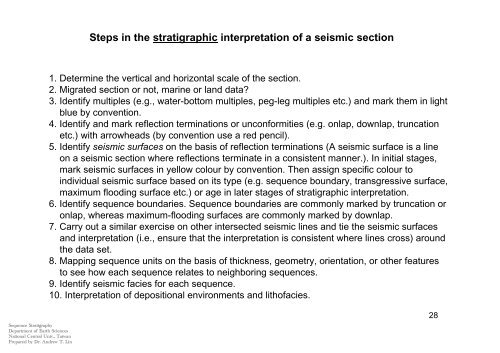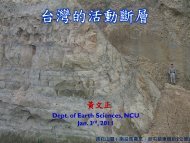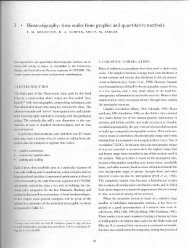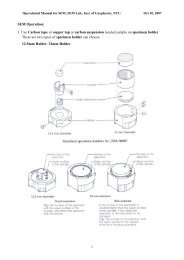10. Seismic Stratigraphy
10. Seismic Stratigraphy
10. Seismic Stratigraphy
You also want an ePaper? Increase the reach of your titles
YUMPU automatically turns print PDFs into web optimized ePapers that Google loves.
Steps in the stratigraphic interpretation of a seismic section<br />
1. Determine the vertical and horizontal scale of the section.<br />
2. Migrated section or not, marine or land data<br />
3. Identify multiples (e.g., water-bottom multiples, peg-leg multiples etc.) and mark them in light<br />
blue by convention.<br />
4. Identify and mark reflection terminations or unconformities (e.g. onlap, downlap, truncation<br />
etc.) with arrowheads (by convention use a red pencil).<br />
5. Identify seismic surfaces on the basis of reflection terminations (A seismic surface is a line<br />
on a seismic section where reflections terminate in a consistent manner.). In initial stages,<br />
mark seismic surfaces in yellow colour by convention. Then assign specific colour to<br />
individual seismic surface based on its type (e.g. sequence boundary, transgressive surface,<br />
maximum flooding surface etc.) or age in later stages of stratigraphic interpretation.<br />
6. Identify sequence boundaries. Sequence boundaries are commonly marked by truncation or<br />
onlap, whereas maximum-flooding surfaces are commonly marked by downlap.<br />
7. Carry out a similar exercise on other intersected seismic lines and tie the seismic surfaces<br />
and interpretation (i.e., ensure that the interpretation is consistent where lines cross) around<br />
the data set.<br />
8. Mapping sequence units on the basis of thickness, geometry, orientation, or other features<br />
to see how each sequence relates to neighboring sequences.<br />
9. Identify seismic facies for each sequence.<br />
<strong>10.</strong> Interpretation of depositional environments and lithofacies.<br />
Sequence <strong>Stratigraphy</strong><br />
Department of Earth Sciences<br />
National Central Univ., Taiwan<br />
Prepared by Dr. Andrew T. Lin<br />
28










